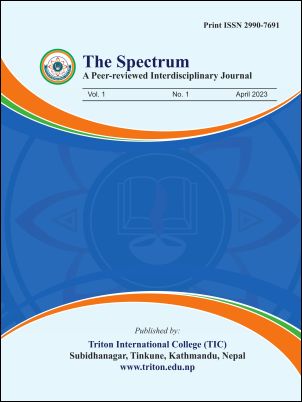Body Purity in Cultural Discourse: An Alternative to Woman's Liberation in Nabin Subba’s Numafung
DOI:
https://doi.org/10.3126/spectrum.v1i1.54928Keywords:
Discourse, Bodies, Limbu, Purity, MarriageAbstract
The notion of purity of women in Nepali society is practiced as a discourse as qualitative measurement of their existence. However, the discourse in shaped and conditioned by various cultural mores and normativities. This discourse, neutralizing their status without comprehending their aspirations and grievances, subordinates women. In this light, this paper, deploying Foucauldian notion of discourse, Simone de Beauvoir’s concept of the female, analyzes concept of purity of body as depicted in Nabin Subba's movie, Numafung. Moreover, it argues that Numafung challenges the prevailing notion and presents an alternative depiction of a woman’s body from a cultural location, representing the aesthetic of the Limbu people. The protagonist of the movie, Numa, debunks the pervasive social structure, getting married three times in different forms. The movie presents a case that although the dominant group may disseminate discursive truths, minimal affirmation of subordinated groups keeps on jeopardizing the discourse through their cultural practices. Thus, analysis implies that cultural inclusion and the recognition of subordinated groups in the practice of societal values can be an alternative through which women’s liberation is possible.
Downloads
Downloads
Published
How to Cite
Issue
Section
License
Copyright (c) 2023 Dipankar Senehang

This work is licensed under a Creative Commons Attribution-NonCommercial 4.0 International License.
This license allows reusers to distribute, remix, adapt, and build upon the material in any medium or format for non-commercial purposes only, and only so long as attribution is given to the creator.




